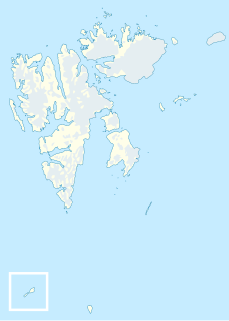
Svalbard and Jan Mayen is a statistical designation defined by ISO 3166-1 for a collective grouping of two remote jurisdictions of Norway—Svalbard and Jan Mayen. While the two are combined for the purposes of the International Organization for Standardization (ISO) category, they are not administratively related. This has further resulted in the country code top-level domain .sj being issued for Svalbard and Jan Mayen, and ISO 3166-2:SJ. The United Nations Statistics Division also uses this code, but has named it Svalbard and Jan Mayen Islands.

Van Mijenfjorden is the third-longest fjord in Norway's Svalbard archipelago. It lies in the southern portion of Spitsbergen island, south of Nordenskiöld Land and north of Nathorst Land. The fjord is 83 km (52 mi) long, being separated from Bellsund further out by Akseløya and Mariaholmen. The settlement of Sveagruva lies on the fjord's north bank.

Akseløya is a long, narrow island at the mouth of Van Mijenfjorden, separating Van Mijenfjorden from Bellsund. It is separated from the mainland by Akselsundet to the north, and another narrow strait to the south. The islands are named after the schooner Aksel Thordsen, which was chartered by Adolf Erik Nordenskiöld for an expedition to Svalbard in 1864.

Bölscheøya is an island southwest of Negerpynten, the southeastern point of Edgeøya. It is part of Thousand Islands. The island was named in 1868 by the German geographer August Petermann (1822–78) after the German journalist Carl Bölsche, father of the German writer and zoologist Wilhelm Bölsche (1843–93). The remains of a whaling station from the 17th century can be found on the island.

Meinickeøyane is an island group composed of two islets, Store Meinickeøya and Vesle Meinickeøya, that form part of Thousand Islands, an island group south of Edgeøya, part of the Svalbard archipelago. They were named after the German geographer Carl Eduard Meinicke (1803–76).
Trønderen is an islet in Brækmoholmane, part of Thousand Islands, an island group south of Edgeøya. The island is named after Trøndelag, Norway, the birthplace of Sivert Brækmo (1853–1930), a Norwegian sailor and fishermen who regularly visited Svalbard between 1876 and 1895.
Store Meinickeøya is the largest island in Meinickeøyane, part of Thousand Islands, an island group south of Edgeøya.
Teisten is an islet in Menkeøyane, part of Thousand Islands, a Norwegian island group south of Edgeøya.
Islomen is a small rocky island, or skerry, in the southeastern part of Menkeøyane, part of Thousand Islands, a Norwegian archipelago south of Edgeøya.
Blåmåken is the northeasternmost island in Menkeøyane, part of Thousand Islands, a Norwegian archipelago south of Edgeøya.
Alka is a Norwegian islet between Gassen and Havella in Menkeøyane, part of Thousand Islands, an archipelago south of Edgeøya.
Gassen is the westernmost of the large islets in Menkeøyane, part of Thousand Islands, a Norwegian archipelago south of Edgeøya.
Havella is the largest islet in Menkeøyane, part of Thousand Islands, a Norwegian archipelago south of Edgeøya. It is named after the long-tailed duck, a migrant to Svalbard.
Zieglerøya is an island off the headland Andréetangen at the eastern side of Tjuvfjorden, at the southern side of Edgeøya, Svalbard. Total area of the island is approximately 2,8 km2. The island is possibly named after either German Arctic explorer Phil. Alex. Ziegler, or Swiss cartographer Jakob Melchior Ziegler.
Andréetangen is a headland at the eastern side of Tjuvfjorden at Edgeøya, Svalbard. The headland is named after German geographer Karl Andrée. Off the headland are the two islands Zieglerøya and Delitschøya.
Delitschøya is an island off Andréetangen at the eastern side of Tjuvfjorden, at Edgeøya, Svalbard. It is located nearby the island Zieglerøya. The island is named after geographer Otto Delitsch.
Dunøysundet is a bay in the Norwegian archipelago of Svalbard. It is located near many other bays such as Nottinghambukta and is located relatively close to Longyearbyen. Most of the islands to the west of it are located within the Dunøyane Bird Sanctuary.





